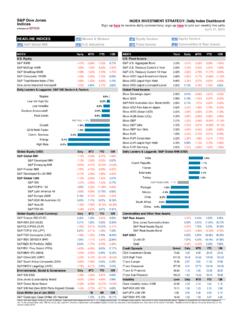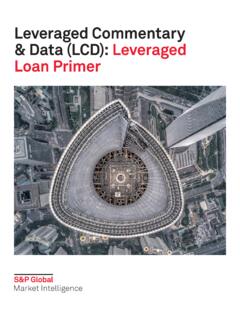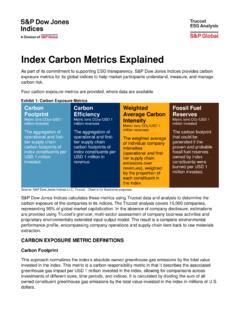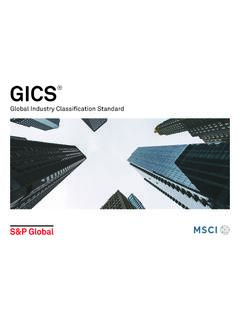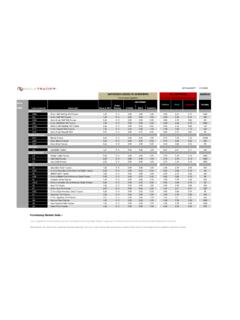Transcription of The Impact of Rising Interest Rates on REITs - S&P Global
1 RESEARCH Real Estate CONTRIBUTORS Michael Orzano, CFA Head of Equity Indices John Welling Associate Director Equity Indices The Impact of Rising Interest Rates on REITs Over the past 25 years, real estate investment trusts ( REITs ) have emerged as a popular and efficient way for market participants of all stripes to access the real estate asset class. Strong long-term total returns, combined with other key investment characteristics such as liquidity, high dividend yields, and their potential to increase diversification and to hedge against inflation, have contributed to the appeal of REITs .
2 Today, however, there is growing concern about how REITs will perform when Interest Rates ultimately rise from their current subdued levels. Exhibit 1: REITs Outperform Other Major Asset Classes Source: S&P dow jones Indices LLC; Barclays Capital. Data from May 31, 1992 to May 31, 2017. REITs , Stocks, Bonds, and Commodities are represented by the dow jones Select REIT Index, the S&P 500 , Barclays Capital Aggregate Index, and the S&P GSCI, respectively. Past performance is no guarantee of future results. Chart is provided for illustrative purposes and reflects hypothetical historical performance.
3 Please see the Performance Disclosure at the end of this document for more information regarding the inherent limitations associated with back-tested performance. It is commonly asserted that REITs are destined to underperform when Interest Rates rise. However, an examination of the historical record suggests that this is a misconception. Although Interest Rates certainly affect real estate values and, therefore, the performance of REITs , Rising Interest Rates do not necessarily lead to poor returns. Since the early 1970s, there have been six periods during which 10-Year Treasury Bond yields rose significantly.
4 In four of those six periods, REITs earned positive total returns, and in half of those periods, Total ReturnToday, there is growing concern about how REITs will perform when Interest Rates ultimately rise from their current subdued levels. The Impact of Rising Interest Rates on REITs July 2017 RESEARCH | Real Estate 2 REITs outperformed the S&P 500. In one of the periods, REITs and the S&P 500 essentially posted identical performances, and in only two periods did the S&P 500 outperform REITs (see Exhibit 2). Exhibit 2: REIT Performance During Sustained Periods of Rising Interest Rates TIME PERIOD 10-YEAR TREASURY YIELD CUMULATIVE TOTAL RETURN OVER PERIOD BEGINNING YIELD (%) ENDING YIELD (%) CHANGE (%) REITs (%) STOCKS (%) DIFFERENCE (%) December 1976-September 1981 January 1983-June 1984 August 1986-October 1987 October 1993-November 1994 October 1998-January 2001 June 2003-June 2006 Source: S&P dow jones Indices LLC, Bloomberg, The Federal Reserve.
5 REIT total returns are based on the FTSE/NAREIT Equity Index from Dec. 31, 1971, to Dec. 31, 1986, and they are based on the dow jones Select REIT Index after Dec. 31, 1986. Stock total returns are based on the S&P 500. Past performance is no guarantee of future results. Table is provided for illustrative purposes and reflects hypothetical historical performance. Please see the Performance Disclosure at the end of this document for more information regarding the inherent limitations associated with back-tested performance. Undoubtedly, Rising Interest Rates pose challenges for REITs .
6 All else being equal, higher Interest Rates tend to decrease the value of properties and increase REIT borrowing costs. In addition, higher Interest Rates make the relatively high dividend yields generated by REITs less attractive when compared with lower-risk, fixed income securities, which reduces their appeal to income-seeking investors. While it would require a much more detailed study to attempt to determine why REITs have generally fared well in Rising Interest rate environments, it is clear that Rising Interest Rates are associated with other factors that positively affect REIT fundamentals.
7 For example, Rising Interest Rates are frequently associated with economic growth and Rising inflation, both of which are likely to be positive for real estate investments. Healthy economic growth tends to translate into greater demand for real estate and higher occupancy Rates , supporting growth in REIT earnings, cash flow, and dividends. In inflationary periods, real estate owners typically have the ability to increase rents, and REIT dividend growth has historically exceeded the rate of inflation as a result. As depicted in Exhibit 3, the income component of REIT returns has exceeded inflation (as measured by the Consumer Price Index [CPI]) in 14 out of the past 15 years.
8 Rising Interest Rates pose challenges for REITs . The Impact of Rising Interest Rates on REITs July 2017 RESEARCH | Real Estate 3 Exhibit 3: REIT Income Has Outpaced Inflation Source: S&P dow jones Indices LLC; The Bureau of Labor Statistics. Data as of Dec. 30, 2016. REIT Income Return is calculated as the annual difference in return between the dow jones Select REIT Index (PR) and dow jones Select REIT Index (TR). Past performance is no guarantee of future results. Chart is provided for illustrative purposes. A NOTE ON UNEXPECTED SHORT-TERM Interest RATE CHANGES When expectations about future Interest Rates change suddenly, REITs (as well as other asset classes) have often experienced high volatility and rapid price changes.
9 This phenomenon was evident in May 2013, when Fed Chair Ben Bernanke suggested that the QE taper could start earlier than most market participants expected. The chair s comments led to a sharp selloff of REITs and of some other asset classes, such as emerging market equities, which were viewed as reliant on easy money from the Fed. The dow jones Select REIT Index dropped from its peak on May 21, 2013 (the day preceding the Fed comments), to its 2013 low on Aug. 19, 2013. However, as markets calmed, the index recovered, subsequently reaching new highs in 2014, and it has continued to rise along with broad-based equity gains in 2017.
10 CONCLUSION Ultimately, whether Interest Rates are Rising or falling does not seem to be the key driver of REIT performance over medium- and long-term periods. Rather, the more important dynamics to address are the underlying factors that drive Rates higher. If Interest Rates are Rising due to strength in the underlying economy and inflationary activity, stronger REIT fundamentals may very well outweigh any negative Impact caused by Rising Rates . 0%1%2%3%4%5%6%7%8%9%10%20022003200420052 0062007200820092010201120122013201420152 016 REIT Income ReturnCPIWhen expectations about future Interest Rates change suddenly, REITs have often experienced high volatility and rapid price changes.

